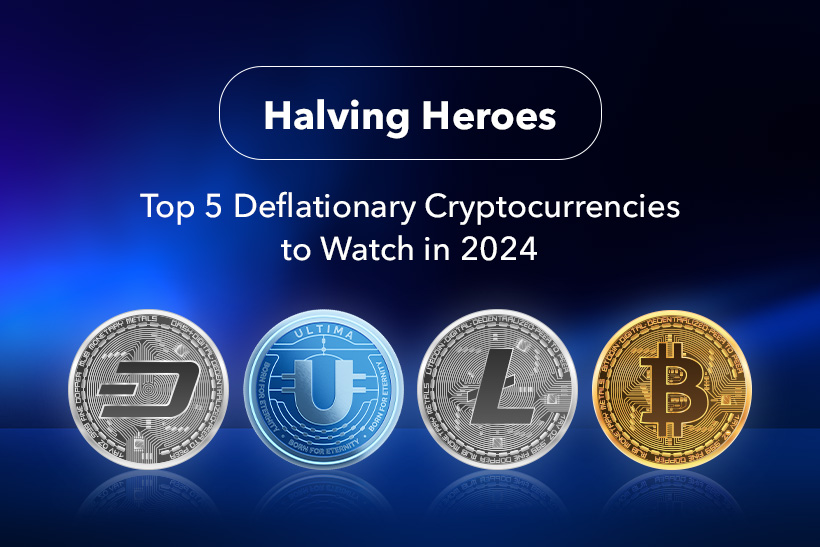
The halving event, a highly anticipated occurrence in the cryptocurrency realm, holds immense significance for market prices and investor sentiment. It reduces miners' rewards, impacting inflation and currency value. As Bitcoin's halving event approaches, it's crucial to understand its historical influence on prices and interest in alternative cryptocurrencies. Notably, various other cryptocurrencies with halving mechanisms or similar deflationary attributes are also gearing up for their respective halving events.
This article highlights the top 5 deflationary cryptocurrencies to watch in 2024, each with a unique approach to managing supply and nurturing value. These cryptocurrencies are considered "digital gold," providing a hedge against inflation and currency devaluation.
1. ULTIMA: The Rising Star
ULTIMA emerges as a cryptocurrency worth keeping an eye on, especially with its first halving event that took place recently, in February 2024. This significant milestone has marked a pivotal moment in ULTIMA's journey, potentially catapulting it into the spotlight of the crypto world. What sets ULTIMA apart is its hyper-deflationary model, a strategic approach designed to significantly reduce the rate at which new ULTIMA tokens enter circulation.
The recent halving has effectively slashed block findings by half. This reduction in new tokens not only curtails the supply but also amplifies the scarcity of ULTIMA tokens. In a market where demand often dictates value, this scarcity could lead to an appreciable increase in ULTIMA's worth. The underlying principle is simple yet powerful: as the available supply dwindles, the value of each token is poised to rise, assuming demand remains constant or increases.
The deflationary model is only one part of ULTIMA's appeal. With a total supply of just 100,000 tokens, this cryptocurrency is sure to be highly sought-after for years to come. With its community expanding at a fast pace, ULTIMA is poised for a possible demand explosion. With roughly 3 million users throughout the globe, the ecosystem's dedication to combining blockchain technology with the traditional economic system has created a strong and engaged community. An increase in demand and, thus, ULTIMA's value after the halving is anticipated to be driven in large part by this surge in community and user involvement.
2. Litecoin (LTC): The Silver to Bitcoin's Gold
Litecoin, often heralded as the silver to Bitcoin's gold, shares a similar halving mechanism to its more illustrious counterpart. This process, occurring approximately every four years, is a testament to Litecoin's commitment to maintaining a deflationary currency model. By halving the rewards for miners, Litecoin ensures that its supply growth rate slows down over time, mirroring the scarcity-driven value proposition that Bitcoin leverages.
Past halvings have been watershed moments for Litecoin, each leaving a distinct imprint on its value and the miner community. The aftermath of these events typically sees a flurry of activity and speculation, with the value of Litecoin experiencing notable fluctuations. These periods are crucial for miners, as the reduced rewards force them to reassess their operations, often leading to increased efficiency and innovation within the mining community.
The crypto community is eagerly anticipating Litecoin's upcoming halving event, with many anticipating a surge in its value due to supply tightening. However, the true impact depends on factors like market sentiment, global economic conditions, and advancements within the Litecoin ecosystem, highlighting the potential for significant market dynamics.
3. Bitcoin Cash (BCH): Aiming for Scalability
Bitcoin Cash (BCH) was created in August 2017 after a heated debate over scalability and transaction fees within the Bitcoin community. The main goal was to increase the block size limit from 1 MB to 8 MB (and later to 32 MB), enabling more transactions per block and reducing fees and transaction times. This move aimed to make BCH more practical for everyday transactions and improve its scalability as a digital currency.
BCH also has a halving mechanism, occurring every four years after 210,000 blocks have been mined, which reduces the block reward for miners to control inflation. The first halving occurred in April 2020, aligning with Bitcoin's schedule.
The effects of previous halvings on Bitcoin Cash's ecosystem and price have been mixed. The 2020 halving, for instance, did not result in an immediate significant price surge as some might have expected. This could be attributed to the broader market conditions at the time and the fact that BCH, while popular, does not command the same level of market attention as Bitcoin. However, the halving did emphasize Bitcoin Cash's commitment to maintaining a controlled supply, which is crucial for long-term value retention.
4. Dash (DASH): A Smoother Approach to Reduction
Dash, formerly Darkcoin and XCoin, is a cryptocurrency known for its focus on privacy and instant transactions. Its unique approach to managing its token supply involves a smooth reduction in block rewards every 210,240 blocks, approximately once a year, to avoid market volatility associated with sudden halving events.
This gradual reduction impacts miners by providing a more predictable revenue stream, allowing them to adjust their operations gradually rather than facing the abrupt income cuts typical of halvings. For the overall stability of Dash's market value, this method can mitigate sharp price fluctuations following reward reductions. By avoiding these sudden changes, Dash aims to foster a more stable economic environment for both users and investors.
Dash's steady security measures and slow decrease method may entice miners who value stability more than the more common half cycles. This is in line with Dash's objective of providing an easy-to-use digital currency for regular transactions, which might increase its appeal to a wider audience and strengthen its dedication to long-term development and sustainability.
5. ZCash (ZEC): Privacy and Scarcity
ZCash (ZEC) is a cryptocurrency known for its strong focus on privacy, offering users the option to protect their transactions. Its halving mechanism, similar to Bitcoin's, reduces the reward for mining new blocks by half every four years. This not only limits the supply of new ZEC but also aligns with the goal of creating a secure, private digital currency for value storage and exchange.
Historically, ZCash's halving events have sparked interest among privacy-focused communities and investors seeking cryptocurrencies with scarcity and enhanced privacy features. These events have led to speculation and increased market activity, with the impact varying based on market conditions and investor sentiment.
With further halvings on the horizon, ZCash should continue to gain traction in the privacy-conscious industry. The need for digital currencies that provide strong privacy safeguards is anticipated to grow in response to the increasing monitoring. If you value your financial privacy, you may want to look at ZCash. Its privacy features and halving process make it a rare and interesting choice.
Unearthing Opportunities in Halving Heroes
Understanding the various approaches to halving across different cryptocurrencies is crucial for crypto enthusiasts. While Bitcoin's halving events tend to dominate headlines, other cryptocurrencies like ZCash and ULTIMA offer unique opportunities thanks to their deflationary mechanisms. In conclusion, while Bitcoin's halving will undoubtedly continue to capture much of the attention in the crypto world, savvy observers and investors will do well to monitor other cryptocurrencies as well. By understanding the unique attributes and strategies of these "Halving Heroes," individuals can better navigate the complex and ever-changing cryptocurrency market.
* This is a contributed article and this content does not necessarily represent the views of techtimes.com









